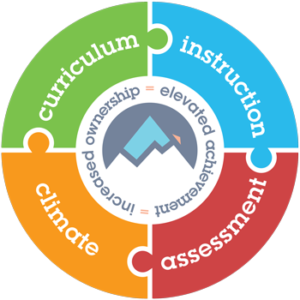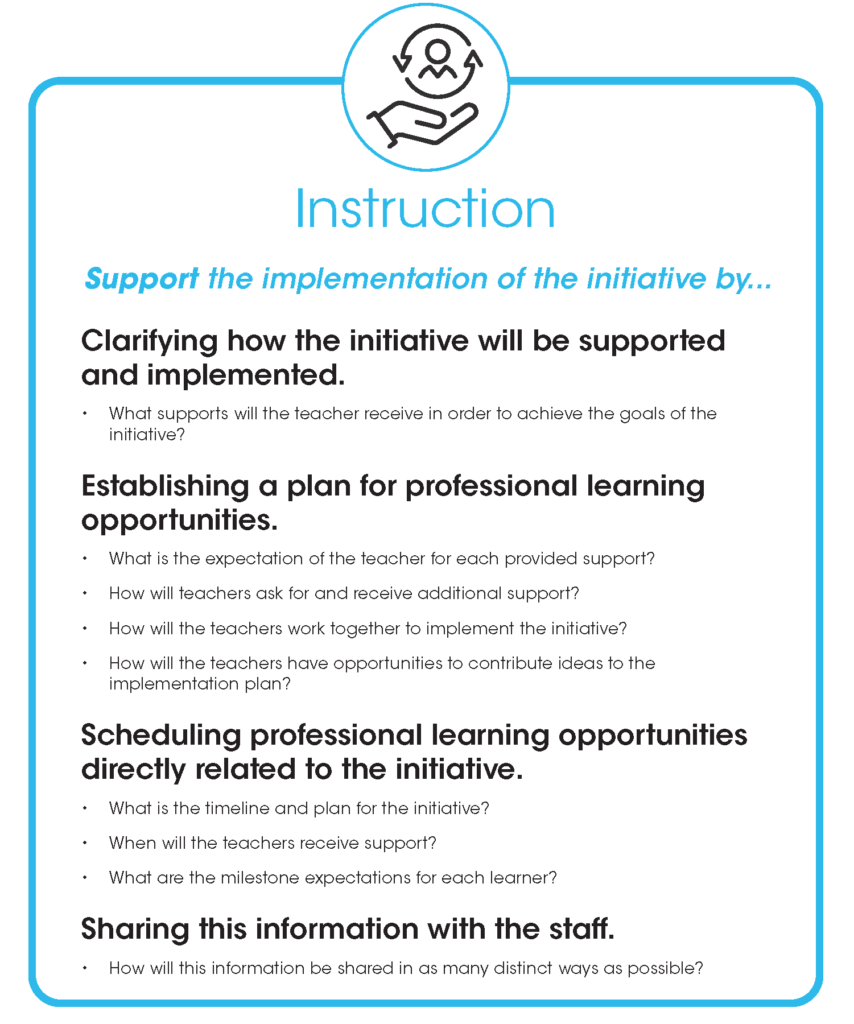Share this article.
An article for school administrators and aspiring administrators
Dear educator, we believe that of all the skills a principal needs to succeed, the most vital, in terms of increasing academic achievement, is that of instructional leadership. And the skill of instructional leadership is made up of actions that can be seen and heard. We also believe that the actions of instructional leadership can be developed.
 You believe this, too, otherwise you would not have clicked on this article.
You believe this, too, otherwise you would not have clicked on this article.
We, at Elevated Achievement, want to support you in building your dream school. That’s why this article is part of a series of articles that show current principals, assistant principals, and future administrators how to turn your dream into your reality by developing the actions of instructional leadership in curriculum, instruction, assessment, and climate.
This article focuses specifically on the second action—the action of instructional leadership in instruction: Determine the support for the implementation of the initiative.
Developing Instructional Leadership
First, we want to be clear. When we talk about the skill of instructional leadership, we are talking about the art of inspiring a group of people toward achieving a common set of goals for learning and academic achievement. And the group of people that have the most significant effect on student achievement are the classroom teachers. Time and again, research bears out that effective teachers are the most important factor contributing to student achievement. As RAND Education (2021) reminded us,
“…research suggests that among school-related factors, teachers matter most. When it comes to student performance on reading and math tests, a teacher is estimated to have two to three times the impact of any other school factor, including services, facilities, and even leadership (p. 1).”
In other words, because your teachers are key to the implementation of any initiative focused on elevating student achievement, you must get them to own their role in the implementation of this initiative and the learning it requires. And, you can achieve this by being a principal who develops the skill of instructional leadership.
Let’s start by focusing on the second action—the action of instructional leadership in instruction.
The Second Action of Instructional Leadership
The second action is to determine the support for the implementation of the initiative. This support should come in a variety of professional learning opportunities—the initial instruction on the initiative, demonstrations of successful implementation within and outside of the classroom, co-planning/co-teaching sessions, collaborative meetings, and opportunities to share ideas with one another. As a principal, you can think of this support as the instruction of the initiative.
In order to lead the successful implementation of an initiative, the principal needs to understand and share the answers to the following questions:
- What support will the teachers receive?
- When will the teachers receive support?
- How will the teachers work together to implement the initiative?
- How will this information be shared with the teachers?
This means that the principal must clarify how the initiative will be supported and implemented, establish a plan for professional learning opportunities, schedule professional learning opportunities directly related to the initiative, and share this information with the staff.
This tool is provided as a resource for you to use when determining the support for the implementation of your initiative.
An Example of Instructional Leadership in Instruction
Principal Washington leads an urban elementary school grades K-5. Talking with teachers, looking at data from this year, and listening to what students were saying about online school, the leadership team decided to focus on informational text strategies. For their 2021–2022 initiative, they selected Reciprocal Teaching as the strategy to implement that would best meet the needs of their students and help everyone gain needed literacy skills.
Once this initiative was chosen, Principal Washington knew her task was to determine and lead these actions:
- Clarify how the initiative will be supported and implemented.
- Establish a plan for professional learning opportunities.
- Schedule professional learning opportunities directly related to the initiative.
- Share this information with the staff.
She began the process by answering the questions from the planning tool above.
What supports will the teacher receive in order to achieve the goals of the initiative?
PRINCIPAL WASHINGTON:
“Because the learning needed to successfully have students working together to make meaning from text is so complex, I know that my teachers will need a variety of supports and time to practice. The initial support opportunities are going to be fairly standard for every teacher but then will become individualized once they determine their own needs. The process is straightforward. First, everyone will attend a full-day session on the what, why, and how of Reciprocal Teaching. Next, each teacher will have an opportunity to observe a lesson where the students work in groups using the strategy. This demonstration lesson will include a meeting beforehand and a debrief afterward. If requested, other teachers could have a demo lesson with their students. Each teacher will have an opportunity to be observed with feedback. We have a plan that all of this support would be from an outside provider and I have budgeted for this. After everyone participates in this plan of support, we will begin to individualize. The teachers themselves will let me know what support they need to meet the expected outcomes.”
Once the variety of supports had been determined, Principal Washington then had to determine the following:
What is the expectation of the teacher for each provided support?
How will teachers ask for and receive additional support?
How will the teachers work together to implement the initiative?
How will the teachers have opportunities to contribute ideas to the implementation plan?
PRINCIPAL WASHINGTON:
“It depends on the support. At the initial session, the expectation is that the teachers will gather as much information as possible and begin thinking about how they will implement this strategy in their class. Before the demo lesson, the expectation is that the teachers will have taught their students how to question, clarify, summarize, and predict, along with developing group work norms. After the demo lesson, the expectation is that the teachers will put their students into Reciprocal Teaching talk groups at least once a week, but we are recommending more. From there, the expectation is that the teachers will determine their strengths and areas for growth and develop their own individualized plan.”
“Asking for additional support is a challenge for my teachers because they want to be perfect the first time they do anything. I remind them that this is a learning process and that mistakes will be made. With the team, we developed a support request form that the teacher can use to ask for help. It includes the area of need, how they want the support, and who they want to support them. Because they meet regularly, they can discuss the different options open to them.”
“The teachers will work together during their monthly grade-level meetings. They will have two meetings a month and the second one is going to be focused on the implementation of Reciprocal Teaching. During this time, they can share their progress and difficulties. They also can request sub time to work together to co-plan and co-teach. I am of the mindset, if they want to work together, I will do anything in my power to find them the time. This is also how they can use the support request form.”
“The initial plan was developed at the end of this school year with contributions from a leadership team pulled from third-, fourth-, and fifth-grade teachers. After we determined the need—low reading scores with information text—and the solution—the use of Reciprocal Teaching, we then brainstormed what they would need to implement this strategy within their classrooms. That is how we determined the first part of the support with the outside provider. After that, the teachers will then have a say in their own plan and determine their next steps.”
Principal Washington knew that she wanted to ensure focus on the initiative, so all of the support must be related to the initiative. She wasn’t willing to pull her teachers off the task. So, she then had to determine:
What is the timeline and plan for the initiative?
When will the teachers receive support?
What are the milestone expectations for each learner?
PRINCIPAL WASHINGTON:
“The timeline is pretty simple. Once we decided on Reciprocal Teaching as the initiative for the upcoming year, we knew we would start the year with the initial session. The overall timeline is that the teachers will have the fall semester for the students to learn and practice Reciprocal Teaching. The expectation is that students will then be able to apply and transfer the strategy throughout the winter and spring.”
“Given this timeline, the bulk of the structured support should occur in the fall. After that, the support becomes individualized depending on the needs of the teacher and the students.”
“The milestone expectations are built off of the larger timeline. The largest milestone is in January when the students should be able to effectively and efficiently make meaning from text using the Reciprocal Teaching strategy. The milestones for teachers before January is sequenced. By October, the students will have been taught the four skills of questioning, clarifying, summarizing, and predicting. By the end of October, the students will have experienced the talk group. In November and December, the students will practice the talk group at least once a week. By the time January comes around, they will be proficient in using this comprehension strategy. The next milestones occur in the spring when the students are expected to transfer this skill into all content areas. By May, the expectation is that students will make meaning from any type of text, reflect on their growth, and explain their process for deeper reading.”
To ensure that her message is clearly articulated and understood, Principal Washington had to determine:
How will this information be shared in as many distinct ways as possible?
PRINCIPAL WASHINGTON:
“Sharing the information regarding support for Reciprocal Teaching is actually quite easy. Because we had developed the support plan together, my task is to remind them of our decisions. Before every session, I will ask the group two questions: What are the goals of the initiative? How will today’s session support the implementation of the initiative? We will discuss and make sure we are all on the same page. I will do this before each session—even those I don’t participate in. At the end of those days, I will send the teachers who participated an email and ask them to reflect on the work: What did you learn? How will this help you implement the initiative? What are your next steps? I will always end the emails with a reminder that they can request any support they feel they need. And I will try my hardest to provide it for them.”
So, What’s Next for Principal Washington?
PRINCIPAL WASHINGTON:
“I will spend part of July reviewing the literacy data from this past year, the reflective survey we gave all students in May, and the needs assessment from teachers to set the context for this work. I want my teachers to relax and disconnect this summer. When we get back, I will have the information to remind them of our great decisions.”
So, What’s Next for You?
 What is the practical answer to the question, “What are the actions of a principal who effectively leads a school with the outcome of elevating academic achievement for each and every student?” In other words, “What are the actions of instructional leadership?”
What is the practical answer to the question, “What are the actions of a principal who effectively leads a school with the outcome of elevating academic achievement for each and every student?” In other words, “What are the actions of instructional leadership?”
There are four.
This article has focused on the action of instructional leadership in curriculum: Determine the support for the implementation of the initiative. We have shown you how to utilize this action. We have offered you a tool to support implementation. We have provided a detailed example of what it looks like when a principal utilizing this action.
Want to know more about the actions of instructional leadership in curriculum, assessment, and climate? Check out our other articles in this series:
- “How to Develop an Initiative that Elevates Student Achievement” — the action of instructional leadership in curriculum
- “How to Determine the Monitoring System for an Initiative that Elevates Student Achievement” — the action of instructional leadership in assessment
- “How to Build a Community of Leaders that Elevates Student Achievement” — the action of instructional leadership in climate
Continue the Learning
Check out these articles and resources to continue your learning about this topic…
The Learning Brief
In this article you learned…
- The second action of instructional leadership.
- How to determine the support for an initiative whose successful implementation will elevate student achievement.
- How to implement the second action of instructional leadership with a tool and an example.
Can you imagine building an environment full of motivated, engaged, and eager students who own their learning?
We can.


